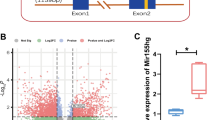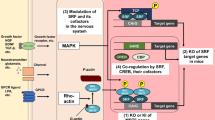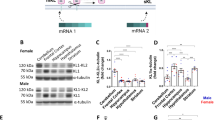Abstract
HIV-1 Tat is a potent transcriptional activator of the viral promoter with the ability to modulate a number of cellular regulatory circuits including apoptosis. Tat exerts its effects through interaction with viral as well as cellular proteins. Here, we studied the influence of p73, a protein that is implicated in apoptosis and cell cycle control, on Tat apoptotic function in the central nervous system. We recently demonstrated the ability of Tat to associate with p73, and that this association modulates Tat transcriptional activity (Amini et al., Mol Cell Biol 2005; 18: 8126–8138). We demonstrated that p73 interferes with Tat-mediated apoptosis by preventing the up-regulation of Bax and down-regulation of Bcl-2 proteins in astrocytes. Thus, the interplay between Tat and p73 may affect Tat contribution to apoptotic events in the brain, limiting its involvement in the neuropathology often observed in the brains of HIV-1 patients.
Similar content being viewed by others
References
Weed MR, Gold LH, Polis I, Koob GF, Fox HS, Taffe MA. Impaired performance on a rhesus monkey neuropsychological testing battery following simian immunodeficiency virus infection. AIDS Res Hum Retroviruses 2004; 20: 77–89.
Wang Z, Trillo-Pazos G, Kim SY, et al. Effects of human immunodeficiency virus type 1 on astrocyte gene expression and function: Potential role in neuropathogenesis. J Neurovirol 2004; 10(Suppl 1): 25–32.
Gray F, Belec L, Chretien F, et al. Acute, relapsing brain oedema with diffuse blood-brain barrier alteration and axonal damage in the acquired immunodeficiency syndrome. Neuropathol Appl Neurobiol 1998; 24: 209–216.
Haughey NJ, Cutler RG, Tamara A, et al. Perturbation of sphingolipid metabolism and ceramide production in HIV-dementia. Ann Neurol 2004; 55: 257–267.
Sperber K, Shao L. Neurologic consequences of HIV infection in the era of HAART. AIDS Patient Care STDS 2003; 17: 509–518.
Wei P, Garber ME, Fang SM, Fischer WH, Jones KA. A novel CDK9-associated C-type cyclin interacts directly with HIV-1 Tat and mediates its high-affinity, loop-specific binding to TAR RNA. Cell 1998; 92: 451–462.
Brigati C, Giacca M, Noonan DM, Albini A. HIV Tat, its TARgets and the control of viral gene expression. FEMS Microbiol Lett 2003; 220: 57–65.
Yik JH, Chen R, Pezda AC, Samford CS, Zhou Q. A human immunodeficiency virus type 1 Tat-like arginine-rich RNA-binding domain is essential for HEXIM1 to inhibit RNA polymerase II transcription through 7SK snRNA-mediated inactivation of P-TEFb. Mol Cell Biol 2004; 24: 5094–5105.
Regulier EG, Reiss K, Khalili K, et al. T-cell and neuronal apoptosis in HIV infection: Implications for therapeutic intervention. Int Rev Immunol 2004; 23: 25–59.
Longo F, Marchetti MA, Castagnoli L, Battaglia PA, Gigliani F. A novel approach to protein-protein interaction: Complex formation between the p53 tumor suppressor and the HIV Tat proteins. Biochem Biophys Res Commun 1995; 206: 326–334.
Levine AJ. p53, the cellular gatekeeper for growth and division. Cell 1997; 88: 323–331.
Kaghad M, Bonnet H, Yang A, et al. Monoallelically expressed gene related to p53 at 1p36, a region frequently deleted in neuroblastoma and other human cancers. Cell 1997; 90: 809–819.
Jost CA, Marin CM, Kaelin WG Jr. p73 is a simian [correction of human] p53-related protein that can induce apoptosis. Nature 1999; 399: 817.
Fulco M, Costanzo A, Merlo P, et al. p73 is regulated by phosphorylation at the G2/M transition. J Biol Chem 2003; 278: 49196–49202.
Levrero M, De Laurenzi V, Costanzo A, Gong J, Wang JY, Melino G. The p53/p63/p73 family of transcription factors: Overlapping and distinct functions. J Cell Sci 2000; 113: 1661–1670.
Minty A, Dumont X, Kaghad M, Caput D. Covalent modification of p73alpha by SUMO-1. Two-hybrid screening with p73 identifies novel SUMO-1-interacting proteins and a SUMO-1 interaction motif. J Biol Chem 2000, 275: 36316–36323.
Sawaya BE, Khalili K, Gordon J, Taube R, Amini S. Cooperative interaction between HIV-1 regulatory proteins Tat and Vpr modulates transcription of the viral genome. J Biol Chem 2000; 275: 35209–35214.
Wong K, Sharma A, Awasthi S, et al. HIV-1 Tat Interactions with p300 and PCAF Transcriptional Coactivators Inhibit Histone Acetylation and Neurotrophin-Signaling Through CREB. J Biol Chem 2005; 280: 9390–9399.
Sawaya BE, Khalili K, Mercer WE, Denisova L, Amini S. Cooperative actions of HIV-1 Vpr and p53 modulate viral gene transcription. J Biol Chem 1998, 273: 20052–20057.
Tafani M, Karpinich NO, Hurster KA, et al. Cytochrome c release upon Fas receptor activation depends on translocation of full-length bid and the induction of the mitochondrial permeability transition. J Biol Chem 2002; 277: 10073–10082.
Morgello S, Gelman BB, Kozlowski PB, et al. The National NeuroAIDS Tissue Consortium: A new paradigm in brain banking with an emphasis on infectious disease. Neuropathol Appl Neurobiol 2001; 27: 326–335.
Liu G, Loraine AE, Shigeta R, et al. NetAffx: Affymetrix probesets and annotations. Nucleic Acids Res 2003; 31: 82–86.
Huber W, von Heydebreck A, Vingron M. Analysis of microarray gene expression data. In: M. Bishop et al., eds. Handbook of Statistical Genetics, 2nd ed. John Wiley & Sons, Chichester, UK: 2003.
Rappaport J, Joseph J, Croul S, et al. Molecular pathway involved in HIV-1-induced CNS pathology: Role of viral regulatory protein, Tat. J Leukoc Biol 1999; 65: 458–465.
Eugenin EA, D'Aversa TG, Lopez L, Calderon TM, Berman JW. MCP-1 (CCL2) protects human neurons and astrocytes from NMDA or HIV-tat-induced apoptosis. J Neurochem 2003; 85: 1299–1311.
Chauhan A, Turchan J, Pocernich C, et al. Intracellular human immunodeficiency virus Tat expression in astrocytes promotes astrocyte survival but induces potent neurotoxicity at distant sites via axonal transport. J Biol Chem 2003; 278: 13512–13519.
Asoh S, Nishimaki K, Nanbu-Wakao R, Ohta S. A trace amount of the human proapoptotic factor Bax induces bacterial death accompanied by damage of DNA. J Biol Chem 1998; 273: 11384–11391.
Collins TJ, Berridge MJ, Lipp P, Bootman MD. Mitochondria are morphologically and functionally heterogeneous within cells. EMBO J 2002; 21: 1616–1627.
Watanabe K, Ozaki T, Nakagawa T, et al. Physical interaction of p73 with c-Myc and MM1, a c-Myc-binding protein, and modulation of the p73 function. J Biol Chem 2002; 277: 15113–15123.
Robert-Guroff M, Popovic M, Gartner S, Markham P, Gallo RC, Reitz MS. Structure and expression of tat-, rev-, and nef-specific transcripts of human immunodeficiency virus type 1 in infected lymphocytes and macrophages. J Virol 1990; 64: 3391–3398.
Park IW, Ullrich CK, Schoenberger E, Ganju RK, Groopman JE. HIV-1 Tat induces microvascular endothelial apoptosis through caspase activation. J Immunol 2001; 167: 2766–2771.
Salzman SA, Burmester JK. HIV-1 tat induced apoptosis of T-cells is not mediated by TGF-beta. Med Oncol 2000; 17: 211–217.
Yang Y, Tikhonov I, Ruckwardt TJ, et al. Monocytes treated with human immunodeficiency virus Tat kill uninfected CD4(+) cells by a tumor necrosis factor-related apoptosis-induced ligand-mediated mechanism. J Virol 2003; 77: 6700–6708.
Gibellini D, Re MC, Ponti C, et al. HIV-1 Tat protects CD4+ Jurkat T lymphoblastoid cells from apoptosis mediated by TNF-related apoptosis-inducing ligand. Cell Immunol 2001; 207: 89–99.
Kruman II, Nath A, Mattson MP. HIV-1 protein Tat induces apoptosis of hippocampal neurons by a mechanism involving caspase activation, calcium overload, and oxidative stress. Exp Neurol 1998; 154: 276–288.
Haughey NJ, Nath A, Mattson MP, Slevin JT, Geiger JD. HIV-1 Tat through phosphorylation of NMDA receptors potentiates glutamate excitotoxicity. J Neurochem 2001; 78: 457–467.
Zauli G, Gibellini D, Caputo A, et al. The human immunodeficiency virus type-1 Tat protein upregulates Bcl-2 gene expression in Jurkat T-cell lines and primary peripheral blood mononuclear cells. Blood 1995; 86: 3823–3834.
Jia H, Lohr M, Jezequel S, et al. The human immunodeficiency virus type-1 Tat protein upregulates Bcl-2 gene expression in Jurkat T-cell lines and primary peripheral blood mononuclear cells. Biochem Biophys Res Commun 2001; 283: 469–479.
Aksenov MY, Hasselrot U, Wu G, et al. Temporal relationships between HIV-1 Tat-induced neuronal degeneration, OX-42 immunoreactivity, reactive astrocytosis, and protein oxidation in the rat striatum. Brain Res 2003; 987: 1–9.
Alonso ME, Bello MJ, Gonzalez-Gomez P, et al. Mutation analysis of the p73 gene in nonastrocytic brain tumours. Br J Cancer 2001; 85: 204–208.
Alisi A, Giambartolomei S, Cupelli F, et al. Physical and functional interaction between HCV core protein and the different p73 isoforms. Oncogene 2003; 22: 2573–2580.
Deb D, Lanyi A, Scian M, et al. Differential modulation of cellular and viral promoters by p73 and p53. Int J Oncol 2001; 18: 401–409.
Lemasson I, Nyborg JK. Human T-cell leukemia virus type I tax repression of p73beta is mediated through competition for the C/H1 domain of CBP. J Biol Chem 2001; 276: 15720–15727.
Park JS, Kim EJ, Lee JY, Sin HS, Namkoong SE, Um SJ. Functional inactivation of p73, a homolog of p53 tumor suppressor protein, by human papillomavirus E6 proteins. Int J Cancer 2001; 91: 822–827.
Ariumi Y, Kaida A, Hatanaka M, Shimotohno K. Functional cross-talk of HIV-1 Tat with p53 through its C-terminal domain. Biochem. Biophys Res Commun 2001; 287: 556–561.
Walker KK, Levine AJ. Identification of a novel p53 functional domain that is necessary for efficient growth suppression. Proc Natl Acad Sci USA 1996; 93: 15335–15340.
Pozniak CD, Radinovic S, Yang A, McKeon F, Kaplan DR, Miller FD. An anti-apoptotic role for the p53 family member, p73, during developmental neuron death. Science 2000; 289: 304–306.
Zaika A, Irwin M, Sansome C, Moll UM. Oncogenes induce and activate endogenous p73 protein. J Biol Chem 2001; 276: 11310–11316.
Author information
Authors and Affiliations
Corresponding author
Rights and permissions
About this article
Cite this article
Saunders, M., Eldeen, M.B., Valle, L.D. et al. p73 modulates HIV-1 Tat transcriptional and apoptotic activities in human astrocytes. Apoptosis 10, 1419–1431 (2005). https://doi.org/10.1007/s10495-005-2467-x
Published:
Issue Date:
DOI: https://doi.org/10.1007/s10495-005-2467-x




